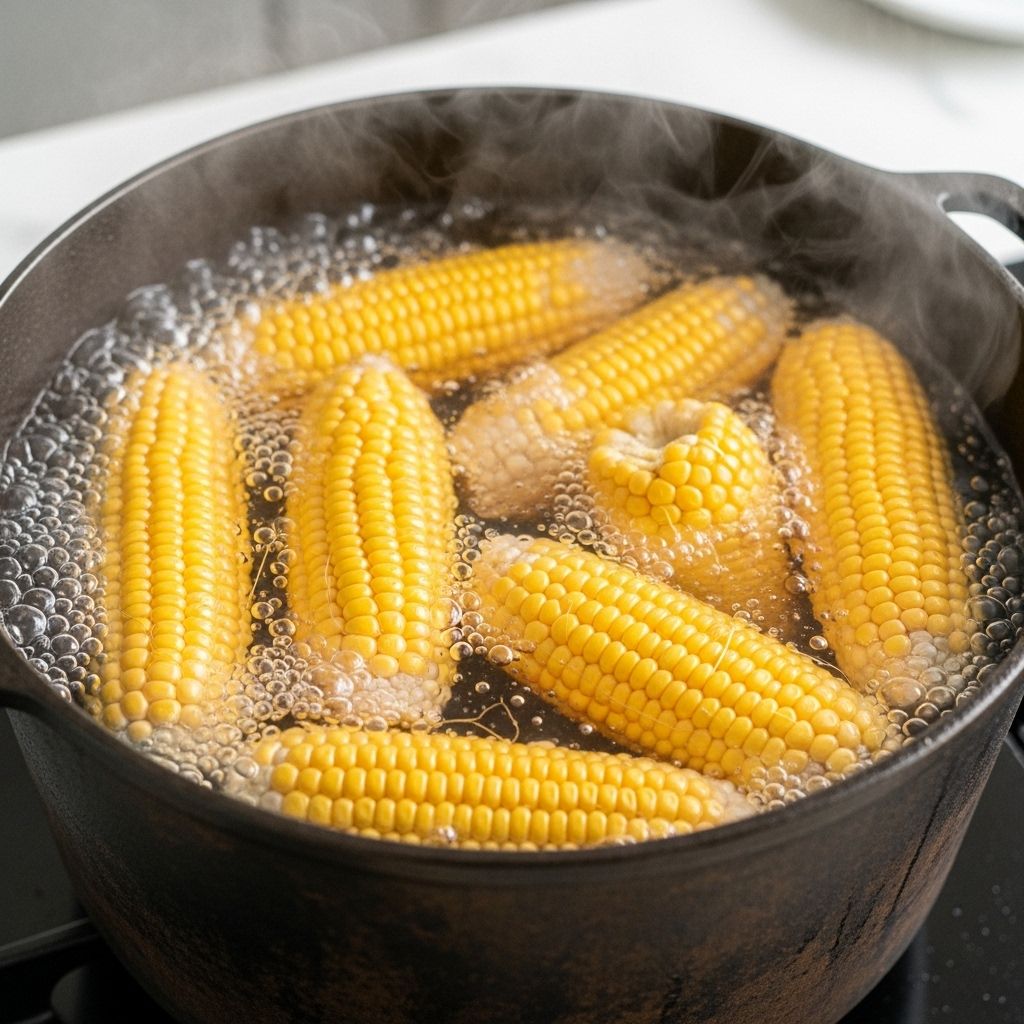How to Boil Corn: The Science and Secrets to Perfect Sweet Corn Every Time
Use residual heat to deliver juicy kernels bursting with natural flavor.

Summer and sweet corn go hand in hand. But boiling corn the right way is less obvious than it might seem. Perfect boiled corn is crisp-tender and bursting with sweet, juicy flavor—not mushy or bland. The process is deceptively simple, but armed with a few scientific insights and expert-tested steps, you can make corn on the cob that’s anything but ordinary. This guide will show you why temperature matters, how to achieve perfect texture, and simple techniques to elevate every ear you cook.
Why Technique Matters: The Science Behind Perfect Boiled Corn
The biggest mistake people make when boiling corn is actually in the boiling itself. Contrary to tradition, you don’t want to keep your corn in actively boiling water. The key is to cook the kernels just enough to set their starches and bring out their natural sweetness, while preserving a crisp, juicy texture. Overcooking leads to tough, gummy, or soggy corn—never ideal for those summer feasts.
- Starch Gelatinization: The starches in corn kernels gelatinize at roughly 150°F (65°C), which gives the corn a creamy, pleasing texture.
- Pectin Breakdown: Pectin, which helps keep kernels firm, begins to dissolve at higher temperatures around 185°F (85°C). If corn is cooked above this for too long, it becomes soft and gummy.
- Boiling Point Issue: Boiling water (212°F or 100°C) is much hotter than needed, risking overcooking and loss of crispness.
So, the secret isn’t to keep boiling. The trick is to bring water to a boil, add the corn, turn off the heat, cover, and let simple physics do its quiet work.
Step-by-Step Guide: How To (Properly) Boil Corn
What You’ll Need
- Fresh ears of corn, shucked and cleaned
- Large pot or Dutch oven
- Water to cover the corn completely
- Salt and pepper (optional)
- Paper towels for drying (optional)
Instructions
- Shuck and Clean the Corn
Remove the husks and all the silks from the ears of corn. Break long ears in half if needed to fit them in your pot.
- Bring Water to a Boil
Fill a large pot with water—enough to fully submerge the corn. Bring it to a rolling boil.
If you’re short on time and want an effortless way to prepare corn, our step-by-step guide on microwaving corn on the cob in the husk is exactly what you need. This method locks in sweetness and saves you from the hassle of boiling! - Add the Corn
Once the water is boiling, use tongs to add the corn. Be careful to avoid splashes.
- Turn Off the Heat and Cover
Immediately turn off the burner or remove the pot from heat. Cover the pot with a lid. (This traps the heat and allows the corn to cook gently without overcooking.)
Still seeking a quick fix? Discover our Quick and Easy Microwave Corn on the Cob recipe, perfect for busy weeknights when you crave delicious corn without the fuss. This method ensures tender, juicy results in mere minutes. - Let Stand
Allow the corn to sit undisturbed in the hot water for 10 minutes (for crisp-tender) or up to 30 minutes for softer corn. The water temperature will sit in the sweet spot for ideal texture.
- Serve Immediately
Use tongs to remove the corn from the pot. Dry with paper towels if desired. Serve hot or warm with butter, salt, and pepper—or any of the flavor boosters below.
Timing Guide: How Long to Boil (or Soak) Corn
| Desired Texture | Time in Hot Water | Result |
|---|---|---|
| Crisp-Tender | 10–12 minutes | Juicy with a pop, perfect for fresh sweet corn |
| Softer Kernels | 15–30 minutes | Tender and mellow, great for those who prefer softer corn |
| Make-Ahead | Up to 1 hour (in hot water off the heat) | Keeps corn warm, does not overcook |
This method is forgiving: your corn won’t become overcooked if you leave it in the hot water for extra time once heat is off, making it ideal for prepping ahead.
The Case Against Constant Boiling
When you maintain a constant boil, corn quickly overshoots the optimal cooking range. Prolonged boiling dissolves the pectin in kernels, turning them mushy and sticky. It can also leach out sweet flavors and aromas. The low-and-slow approach (using residual heat) prevents this by keeping the temperature right where the kernels need to cook gently and thoroughly.
- Boiling for less than 2 minutes = Undercooked, chewy
- Boiling for 10–15 minutes = Tasty, but risking loss of sweetness/flavor
- Soaking in hot water off heat 10–30 minutes = Perfect balance, no mushiness
Flavor Boosters: Beyond Butter and Salt
While fresh, sweet corn is delicious with just butter and salt, there are countless ways to level up your flavor game. Here are a few creative, chef-tested suggestions:
- Seasoned Butters: Add fresh herbs (cilantro, parsley, basil), zest (lime or lemon), spices (smoked paprika, cayenne), or garlic to softened butter before spreading.
- Cheese and Citrus: Crumble cotija or feta over warm corn, squeeze fresh lime or lemon juice, and sprinkle with chili powder.
- Herb Oils: Brush with basil, cilantro, or chive oil for a fresh, peppery taste.
- Spices Directly in the Pot: For subtle flavor, try adding whole peppercorns, bay leaves, or even a few garlic cloves to the water as it boils.
- Sweet or Savory Toppings: Try honey butter, spicy mayo, or miso-butter blends for a new twist.
Buying and Storing Corn: Get the Best Flavor
Flavor starts before you even hit the kitchen. Follow these best practices:
- Buy corn as close to harvest time as possible. Corn’s sugars begin converting to starch as soon as it’s picked, so freshness is essential.
- Leave husks on until ready to cook. The husk acts as natural packaging, preserving moisture and flavor.
- Refrigerate if not using immediately. Cold slows the conversion of sugars to starch, keeping the corn tender and sweet.
- Look for plump, tightly packed kernels. Check that the ears feel heavy for their size and the silk is moist and golden.
Common Questions and Troubleshooting (FAQs)
Do I need to salt the water when boiling corn?
Salting the water is optional and does not toughen the kernels, as some myths suggest. However, it typically does not add much flavor, since corn’s husk and kernels are relatively impervious to dissolved salt. Save your salt for after cooking, where it’ll have the most impact.
Should I add sugar or milk to the water?
No scientific evidence supports the idea that adding sugar or milk significantly sweetens corn. The best flavor comes from using fresh, in-season corn and not overcooking it. If you like a hint of extra sweetness, try a flavored topping instead.
Can I use this method with frozen corn on the cob?
Yes! Drop frozen ears straight into boiling water, then turn off the heat as usual. They may require slightly longer in the hot water. Taste test after 10–12 minutes and continue until hot and tender.
How do I keep boiled corn hot for a picnic or party?
After cooking, leave the corn in the hot water (with heat off). With the lid on, the water will keep the corn warm for up to one hour—ideal for holding before serving a crowd.
What about microwaving or steaming corn?
Both methods work well for small quantities or when you want to retain maximum sweetness. Steaming is especially gentle if you’re worried about overcooking. But for feeding a crowd or prepping ahead, this hot-water soak method is the most forgiving and practical.
Expert Tips for Next-Level Corn Every Time
- Don’t peel corn until ready to cook. Husks lock in moisture and sweetness; shuck just before boiling for best results.
- If prepping ahead, use the steeping method. This method lets you hold corn at a perfect serving temperature without overcooking for flexible timing during busy meals.
- Add a dash of acidity or fat for balance. A squeeze of lime juice or swipe of seasoned butter after cooking makes the flavors pop.
- Try compound butters and dips. From sriracha-lime butter to truffled honey, corn is an ideal blank canvas for creative condiments.
Summary Table: Do’s and Don’ts of Boiling Corn
| Do | Don’t |
|---|---|
| Bring water to a boil, then turn off heat before adding corn | Keep boiling corn throughout cooking (leads to mushiness) |
| Let corn sit in hot water for 10–30 minutes | Boil for more than 10 minutes—risk tough, bland results |
| Use toppings to boost flavor after cooking | Rely on flavoring the water |
| Buy and store fresh corn properly | Leave husked corn unrefrigerated overnight |
Recipe Variations and Serving Suggestions
- Mexican Street Corn (Elote): Brush hot corn with mayo, sprinkle with cotija cheese, chili powder, and lime juice.
- Herby Corn Salad: Slice kernels off the cob and toss with fresh tomatoes, basil, olive oil, and feta.
- Corn Chowder: Use freshly boiled corn for a base in summer chowder recipes.
- Grilled-then-Boiled Corn: Grill ears first for smoky flavor, then finish with a brief steep in hot water to plump up the kernels.
Whether you’re serving a backyard feast, prepping a picnic, or elevating a weeknight dinner, perfectly cooked corn is a guaranteed crowd-pleaser. Master the science, respect the details, and enjoy the sweet rewards of better boiled corn—every time.
References
Read full bio of Shinta












